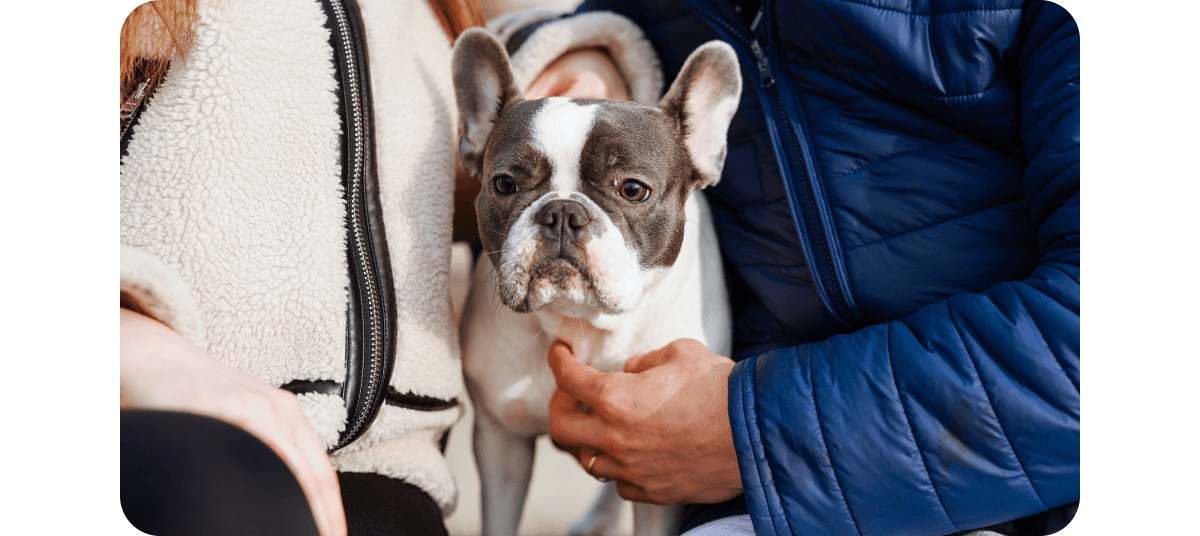Everything you need to know about English Cocker Spaniels

Summary
A great gundog that’s now a popular pet. It’s hard to resist the cute Cocker Spaniel!
Key Stats
Height
38 to 44 cm
Weight
11 to 15 kg
Size
Small
Lifespan
11 to 13 years
Coat
Medium, curly
Exercise
1 to 2 hours daily
Grooming
Weekly
Temper
Friendly, energetic, playful
Breed history
Spaniels, including English Cocker Spaniels, have centuries of history. But although they’ve existed for over 500 years, they were no specific breeds until the 1800s.
The Cocker Spaniel was bred as a working gundog. Originally, they were the same as the English Springer Spaniels. But when a Springer weighed less than 9kg, they were used to hunt woodcock and became known as “Cockers”.
This happened with other spaniels too, like the Sussex Spaniel. When a dog was smaller than average, they were known as Cockers.
Eventually, Cockers became their own breed and divided into two lines, one for showing and one for working. And although they are still widely used as working dogs as gundogs and detection dogs, the English Cocker Spaniel has become one of the most popular pet dogs in the UK.

Meet Nala the Cocker Spaniel
This gorgeous girl is Nala the Cocker Spaniel! She's insured with Napo and gets up to all sorts of adventures which you can follow on instagram @nalaandalfiesadventures. Thank you Rachael for the photo! 💙
Appearance
Cocker Spaniels are compact dogs, about as tall as they are long. Like most spaniels, they have long ears covered in thick curly fur. Their coat is medium length and can be sleek or curly, and has longer “feathers” on their legs and chest. They’re also well-known for their round, dark eyes which give them an adorable puppy-eye appearance.
Cocker Spaniel colours
English Cocker Spaniels have a wide variety of colours and patterns, more than most breeds of dog. The Cocker Spaniel colours recognised by the breed standard are:
-
Black
-
Black and white
-
Black, white, and tan
-
Black and tan
-
Red
-
Red and white
-
Red roan
-
Golden
-
Lemon
-
Lemon and white
-
Lemon roan
-
Blue roan
-
Blue roan and tan
-
Liver
-
Liver and white
-
Liver and tan
-
Liver, white, and tan
-
Liver roan
-
Liver roan and tan
-
Sable
-
Sable roan
Cocker Spaniel temperament
The typical Cocker Spaniel temperament is active, bright, and loving. As the breed standard says, they have a “merry nature with an ever-wagging tail”, and they are a very happy go lucky pup.
As well as being cheerful and good-natured, English Cocker Spaniels are very affectionate. They dote on their human family members, and can be prone to separation anxiety without training. They’re also well known for their energy, and they are a typical bouncy and playful Spaniel.
Being so active, and a working breed, you need to be prepared to give your Cocker plenty of exercise and stimulation to prevent boredom. Luckily, these dogs love human company and are as cuddly as they are cute, so it’s hardly a chore to spend time with them!

How much exercise does a Cocker Spaniel need?
Cocker Spaniels were originally bred as a working gundog, so they were born to be out in the field fetching things for hours. Ideally, you should dedicate at least 1 hour a day to walking your Cocker. (Although they certainly won't complain if you can manage more!)
Your dog doesn’t just need physical exercise though. English Cocker Spaniels are clever canines and need mental stimulation too. You can play some indoor games with your pup or carry out regular training to exercise their brains. It’ll build your bond too!
How to groom a Cocker Spaniel
English Cocker Spaniels have a thick double coat, that’s waterproof as long as you don’t clip it. Despite their medium-length fur and curls, they’re pretty easy to care for when it comes to grooming.
You’ll need to brush your Cocker Spaniel at least once a week, preferably twice. Pay particular attention to their feathers and ears, as grass seeds and dirt can get stuck in the long fur.
Cockers only need a bath when they are visibly dirty, or smelly. Although most of the time, just giving them a rub down with a towel after a walk is enough to get any mud off them.
Ideally, you should brush your Cocker Spaniel’s teeth a few times a week too to prevent dental disease. You can find out about how to keep your dog’s teeth clean and healthy in this guide.

Allergies & skin problems
One of the most common Cocker Spaniel health problems is atopy, or allergies. This can cause itchy skin, but it’s also a common cause of ear infections.
Obesity
Cocker Spaniels are one of the breeds most prone to obesity. Their thick curly fur and long feathers can make it hard to check their shape visually and spot extra pudge, so be sure to feel their body. They’re also food-motivated, and will overeat if you let them. Finally, Cockers are a working breed and need a lot of exercise, without which, they’ll start to gain weight.
Pancreatitis
As well as obesity, Cockers are at higher risk of pancreatitis compared to other dogs. This is a condition where the pancreas becomes inflamed, and needs hospitalisation to treat. One of the causes of the condition is eating high-fat foods.
Ear infections
A Cocker Spaniel's characteristic curly ears makes them prone to ear infections. Their long ears with furry insides prevent air flow into the ear, leading to bacteria growth and infection. Give your pup’s ears a regular sniff test, and get your vet to check them if they’re stinky. You can also clean their ears to prevent infection, as advised by a vet.
Hip dysplasia
Hip dysplasia is a common Cocker Spaniel health problem. It’s where the ball and socket of the hip joint doesn’t fit together properly. A good breeder should screen their dogs for the condition before breeding so puppies are less likely to inherit the condition.
Hereditary eye conditions
Cocker Spaniels are more at risk of a condition called progressive retinal atrophy. It’s an inherited condition of the eye which is not painful, but it can cause blindness. Because it’s inherited, it’s important to screen dogs for this condition before breeding them.
Frequently asked questions about Cocker Spaniels
Are Cocker Spaniels easy to train?
Cocker Spaniels are one of the easier breeds to train because they are intelligent and quick learners. These dogs thrive with a job to do, and mental stimulation, so they usually enjoy training.
They’re also eager to please and love people, so will often do as asked and are generally obedient. Finally, they’re usually very food-motived, so they will do anything to get a tiny treat.
When are English Cocker Spaniels fully grown?
Cocker Spaniels reach their adult size when they’re 12 months old, sometimes a little earlier. But they aren’t considered fully grown until 18-24 months old as their skeleton and muscles become fully developed. For more info on how long puppies take to grow, check our puppy growth guide.
However, many people also ask “when do Cocker Spaniels calm down?’ wondering when they might grow out of their energetic, bouncy, puppy phase. Cockers don’t seem to grow out of the puppy mentality as quickly as other dogs. You might be waiting for your Cocker to get to about 3 or 4 years old before they settle down a bit. Don’t hold your breath though, Cockers are enthusiastic and energetic throughout their life.
Does a Cocker Spaniel shed?
Yes, Cocker Spaniels do shed. They have a thick double coat and will lose some hair all year, with heavier shedding periods in Spring and Autumn as they change into their summer or winter coats.
Regularly brushing your Cocker will help to minimise shedding though, as the dead fur will come out the brush and not all over your home.
Many people believe Cockapoos (Cocker Spaniel x Poodle) don’t shed, but this isn't true. Many Cockapoos inherit coats like a Cocker, meaning they will shed.
Are there different types of Cocker Spaniel?
Yes, there are a few different types of Cocker Spaniel.
Firstly, there's the English Cocker Spaniel, and an American Cocker Spaniel. Most of the time, people mean the English Cocker Spaniel when they think of a Cocker Spaniel. This page is all about the English breed!
The American breed is newer and looks a bit different. They’re smaller and have got longer ears, and a more domed head.
As well as the American and English dogs, you get “working” type Cockers, and “show” type Cockers.
What’s the difference between a working Cocker Spaniel and a show Cocker Spaniel?
The biggest difference between a working Cocker and a show Cocker, is their looks.
A working Cocker Spaniel (sometimes called a “field” Cocker) has shorter ears. The feathers on their legs and chest are also shorter, and their fur is typically smoother.
Meanwhile, show Cockers look “showier”. They were bred to be house pets, and shown at dog shows. So they have longer fur that’s usually a lot curlier. They also have longer ears that are set lower down on their head.
Cocker Spaniel vs Springer Spaniel
About a century ago, you could get a Cocker Spaniel and a Springer Spaniel in the same litter of puppies.
When people would breed Springer Spaniels, smaller dogs would be called “Cockers” and used for hunting woodcock. (Hence the name!) Meanwhile, the bigger dogs were known as Springers and would flush larger birds, like pheasants, into the air.
Jump to
Why isn’t my cat using the litter tray?

Why isn’t my cat using the litter tray?
By Rachel Rodgers MSc, Head of Training at Napo Pet Insurance
Blog
10 things you need to know about Frenchies

10 things you need to know about Frenchies
By Rachel Rodgers MSc, Head of Training at Napo Pet Insurance
Blog
Are Frenchies aggressive or stubborn?

Are Frenchies aggressive or stubborn?
By Rachel Rodgers MSc, Head of Training at Napo Pet Insurance
Blog